Foreign Insulators
By Caleb Thimell
Reprinted from "Crown Jewels of the Wire", May 2004, page 7
I begin with an update on the tiny B TE S.G.D.G. No 1 cross top spool from
Belgium. Thanks to Lis and Jim Bergman for sharing the following additional
information. The "B te" is a French abbreviation for "brevete"
which means patent. The S.G.D.G. is short for "Sans Garantie Du
Gouvernement." According to the Nouveau Larousse Universal Dictionary,
1949, this phrase is used to indicate "formula that, affixed on patents of
invention, attest that the State doesn't carry guarantee of the reality,
newness, the merit of the invention, nor the accurateness of its description.
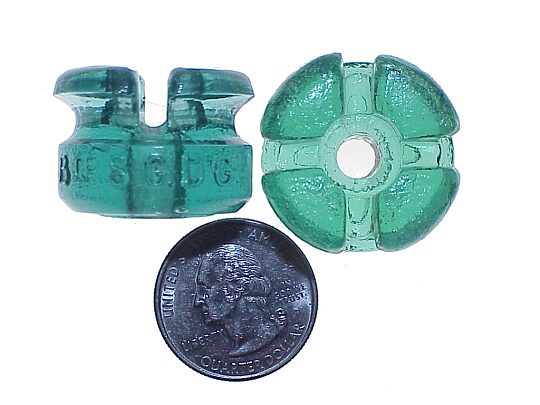
Tiny B TE S.G.D.G No.1 spools, the size of a quarter!
Lis and Jim report this abbreviated marking can be found on many of the
porcelain lid closures to French L'Ideale glass fruit jars. L'Ideale didn't
manufacture anything in porcelain therefore must have contracted out this work,
thus explaining the use of that abbreviation on their lids.
Lis and Jim have a small B TE S.G.D.G. No 1 spool in aqua that measures 1-1/16 diameter and 7/8 inches tall. The one in my collection is smaller (1 inch
diameter by 3/4 inch tall). The minor height variation can be explained by the
excess glass that is trimmed or broken off the base while at the factory. I have
examples of this spool in an attractive green and a rich aqua (see photo).
Upon closer examination I noticed raised ribs on the surface of the entrance to
the nail or screw hole. (see photo). It's unlikely the ribs were designed to
help secure cement or other adhesive to the glass as none of the spools
recovered show any evidence of cement or similar material. Instead I believe
they were designed to be used with a threaded bolt (or similar object) whose
head would rest on these ribs, in a manner that would prevent slipping after it
was tightened in a similar manner as a modern metal washer does. After the knob
is securely fixed to its desired surface, the wires would be wrapped around the
slotted grooves.
I have been unable to confirm the manner of installation of these spools but
it seems reasonable the design itself could provide clues as to its purpose or
use. In Jack Tod's book" A History of Electrical Porcelain" there is a
listing for a porcelain knob with grooved slots on its top and sides and a nail
hole going thru its interior. (See patent 1,527,318 on page 143). This is
identified in Tod's classification system as a "tie wire knob."
Interestingly, this particular knob's patent was assigned to AT&T Co, NY on
February 24,1925. So there is precedent for a tie wire knob being of use to a
major telephone company. Therefore its possible the No.1 spool which shares a
similar design (with some striking differences) was used for low voltage
telephone wire installations and/ or other tie wire uses such as household
interior wiring.
The Bergman's also informed me they have an identical tie wire style knob
spool marked "B TE S.G.D.G. No 3" measuring 1-3/8 inches in diameter
and 1-1/16 inches tall in aqua and medium dark green. To my knowledge, no cd
number has been assigned to either knob. Now we need to find the No 2 spool so
we can have a family!
No evidence has been found to identify the manufacturer of these spools.
However, two potential candidates include Verreries de Folembray and ISOREX. The
Bergman's confirm these French companies have exported insulators to Belgium.
Another possibility is the Belgian insulator manufacturer Verlica Belgium (now
known as VERLIPACK). As one becomes acquainted with insulators from different
companies one can often identify pieces based on the color of the glass. For
example, according to Glass insulators from Outside North America (GIFONA),
ISOREX used primarily deep olive green and sometimes light green or deep teal
blue, whereas Folembray insulators are primarily yellow green and sometimes
light aqua. As more information becomes available I'll keep you posted.
Sinclair-Aitken Insulator
Another unusual insulator that has come to my attention is a British
manufactured U-1929A Sinclair-Aitken insulator, named after its inventors. It was
patented in 1897. It was used primarily on General Post Office lines (and
occasionally seen on early railway lines) as a terminal and a lead-in insulator.
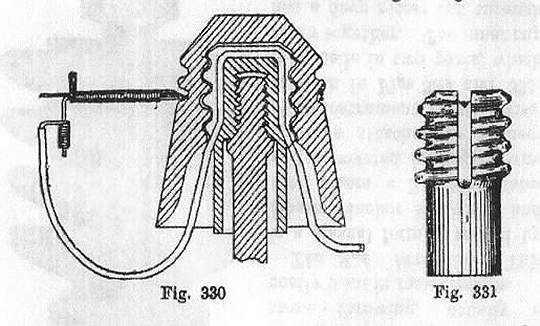
U-1929A Sinclair-Aitken Shadow Profile
For example, when an overhead line terminates and has to be connected to a
lead-in wire, the insulator would be attached either to the side of a building
or directly to a pole. In this case, the lead in wire is inserted and fastened
into the deep groove of the threaded inner shed (figure 331) is then screwed
into the cordeaux shaped shell (figure 330). In figure 326 you can see the
insert is cemented onto a galvanized iron J bolt.
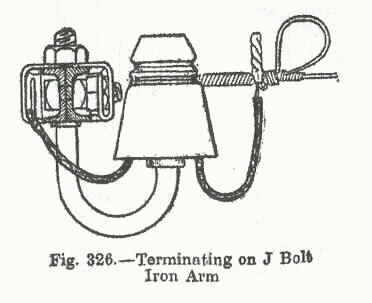
The advantages of this arrangement is that it eliminates turning stress of
line wires in a vertical direction. It also provides flexibility to the wires,
relieving some of the bending and strain that is caused by excessive weather
conditions.
On the next page is a recent photo of an abandoned factory in the Scottish
Highlands. Of note on the wall are ten Sinclair-Aitken insulators patiently
waiting retrieval after seeing service for nearly 100 years! Here you can see
they are all installed using the double J bolts, which indicates they were
installed to accommodate two wires going off at an angle.
Also on the next page, you can see a close up of the U-1929A insulator. It
was made of a high quality, durable porcelain (to prevent puncture and survive
stone throwing) and a highly glossy glaze (to repel moisture and reduce
contamination build up), which were among several of the prerequisites for
British insulators made in the late 1890s.

Abandoned factory in Scotland
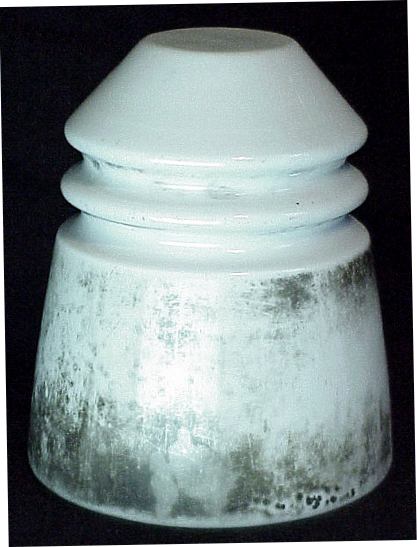
U-1929A
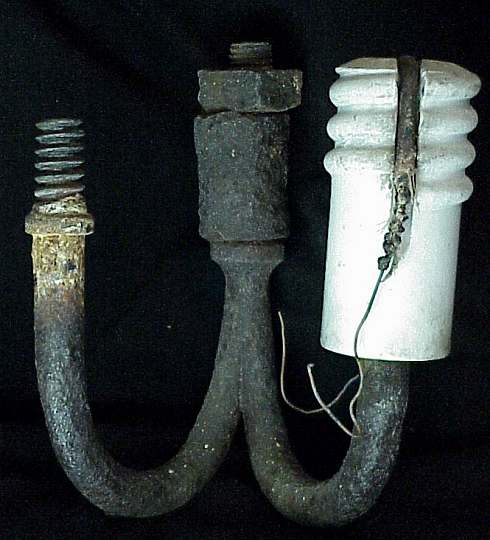
Double J-Bolt
The double J bolt (identical to those on the old factory wall) pins can be
seen in the right-hand photo with the outer shell removed, revealing the
slotted threaded inner cup and the original wire that was used to provide a
"dry spot" to the leading in wire.
| 